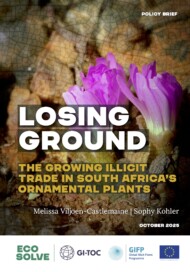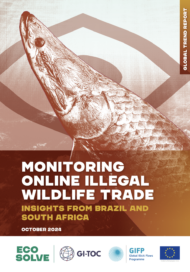Posted on 02 Oct 2025
South Africa is one of the world’s most biodiverse countries, with three globally recognized biodiversity hotspots and exceptionally high levels of endemism. However, this natural heritage is under threat from an expanding illicit trade in ornamental plants.
This new policy brief examines how endangered flora are being systematically removed from the wild to meet international consumer demand for rare or unusual plants. This trade, once limited and opportunistic, has become more organized, commercialized and transnational, with buyers now concentrated in Europe, the US and Asia.
For decades, succulents and cycads were the primary targets of poaching. Today, the trade has broadened, leaving a growing set of ornamental plants vulnerable. Among them, Clivia mirabilis, a critically endangered geophyte endemic to the Oorlogskloof Nature Reserve, emerged as a new trafficking concern in 2023. By August 2025, over 15 000 plants had been illegally removed from the reserve, with more than half the surveyed population lost in a single year.
South Africa’s Conophytum dwarf succulents, which have become emblematic of the illegal plant trade, face similar threats. Their rarity, combined with a houseplant boom and economic vulnerability during the COVID-19 pandemic, drove illegal harvesting to new levels. Since 2019, authorities have seized more than 1.2 million plants across 197 taxa, with 97% of species now threatened with extinction.
Online platforms and social media marketplaces have become central conduits for the trade. Sellers use coded language and closed groups to evade detection, while influencers glamorize rare plants and fuel demand. Casual buyers, often unaware of species’ protected status, can now obtain wild-harvested plants as easily as ordering any other product online.
The impact extends far beyond biodiversity loss. Poaching destabilizes ecosystems, erodes trust between authorities and communities, and undermines vital ecotourism. At the same time, vulnerable animal species, including armadillo girdled lizards and speckled dwarf tortoises, are opportunistically targeted and destined for the illegal wildlife trade. Seized plants, which are often impossible to return to the wild, now overwhelm conservation authorities, leaving conservation agencies with long-term financial burdens.
Despite landmark efforts to combat the trade, such as the National Response Strategy and Action Plan to Address the Illegal Trade in South African Succulent Flora (2022) and the National Integrated Strategy to Combat Wildlife Trafficking (2023), enforcement is hampered by limited capacity in a country already battling high levels of violent crime.
Yet momentum for change is building globally. Upcoming international proposals in 2025 include motions at the IUCN World Conservation Congress and CITES CoP20 that aim to strengthen protections for threatened plant species. These interventions could provide critical pathways for addressing the illegal trade.
The report highlights the urgent need for coordinated responses that address both the ecological and social consequences of the illicit trade in South Africa’s ornamental plants. Without decisive action, the country risks losing irreplaceable species, with cascading effects on biodiversity, communities and the economy.




